Photographs: Reinhard Krause/Reuters Sanchari Bhattacharya in Haridwar
Where is the Mela? That is the question that struck us as we gazed at the dusty spectacle that unfolded before us at Haridwar -- Ground Zero of the Purna Kumbh Mela 2010.
Where is the merry-go-round, the Columbus ride, the magicians, the flying woman, the delicious food stalls and the mouth-watering sweets that we had heard about?
The Purna Kumbha Mela, one of the grandest religious fairs in the last few years, is a less boisterous and glamorous affair than its big brother, the Maha Kumbh Mela held at Prayag. The unprecedented security measures in this year's Mela, which concludes on April 28, have further dampened the festivities.
...
Tents galore but few visitors
Image: Luxury tents at the Mela venuePhotographs: Reuben V
Rows and rows of tents, thousands of them of every possible colour, stretch across the horizon; from small and cosy ones to massive ones that double as makeshift dormitories for hundreds of people. There are even luxurious tents, which come with 5-star facilities and a mind-boggling price tag. Then there are the shabby, decrepit ones for the penniless travellers.
But despite the presence of these tent colonies, there are only a few people visible at the venue of what is regarded as the 'largest religious gathering in the world'. Under the glaring afternoon sun, with gusts of warm wind blowing dust and grime on our faces, we scan the area to find Asia's largest fair.
All roads don't lead to destination
Image: A sadhu in his tent near the banks of the GangaPhotographs: Reinhard Krause/Reuters
Forget delectable savouries, even everyday food stalls selling rajma chawal (red kidney bean-rice) or puri bhaji (unleavened Indian bread with vegetable dish) are rare. Probably failing to perceive any security threat from them, a few chaiwallahs (tea vendor) and several ice-cream vendors have been allowed to operate by the 'mela authority' (as they are called by locals).
Put your intellectual side aside here
Image: An ascetic shops for vegetables in a market at Kankhal, HaridwarPhotographs: Reuben V
We are repeatedly warned against being cynical or judgemental about the religious context of the place or the ceremonial rituals being practised around us. "Here you need to put your intellectual side aside and let your spiritual side take over," says a Kumbh Mela veteran.
Incredulity overpowers every other emotion
Image: A priest performs the evening aarti on the banks of the GangaPhotographs: Reinhard Krause/Reuters
But incredulity overpowers every other emotion soon. As the weather becomes friendlier in the evening, thousands of pilgrims emerge from their tents. Many of them have travelled miles to seek a darshan of the sought-after sadhus here or find their gurus. Some have been staying here days on end, and all they have with them is a potla (a small bundle wrapped in cloth) with few utensils and fewer clothes.
Some of them don't even speak in Hindi. We encounter a couple, who had lost their way and were helplessly asking passers-by for directions in an incomprehensible language. But they do not seem tired, or irritated, or fatigued, or complain about the arrangements (or lack of them).
The people in charge of managing the tents and pandals air their complaints and grievances. Surprisingly, even some sadhus and sadhvis bitterly admonish the administration -- using choicest cuss words at that -- for its apathetical arrangements, the lack of food stalls, drinking water, vehicles, etc.
Everyone is here for something
Image: Foreigners perform yagna at HaridwarPhotographs: Reuben V
The pilgrims comprise families with children in tow, men and women who have ferried their ageing parents for a final teerth (pilgrimage), entire villages who have trudged in uncomfortable buses to get here, the indifferent philosophers who walk around aimlessly through the many pandals, the amused foreigners here for something beyond what Lonely Planet promises, the grumpy youngsters who have been forced to come here by their eager parents, the excited ones who are here to score some marijuana and the truly curious ones who are hoping to find some answers in their 'quest for spiritual enlightenment'.
But that kind of enlightenment seems improbable when we arrive at the main thoroughfare of the Mela, a site designated for the biggest, loudest and most colourful pandals.
Of sadhus, pandals and credentials
Image: Pandal dedicated to various martyrs at the Kumbh MelaPhotographs: Reuben V
There are life-size posters of the various sants and sadhus who lord over these pandals, often called ashrams or nagaris, beckoning the faithful in a manner that will put any reputable PR firm to shame. Most of them have a name adorned with grand prefixes like maharaj, pujit, sant, shree, rashtriya etc.
Some saints are proving their yogic credentials by contorting their bodies into amazing shapes against the backdrop of a cave or a snowy mountain. Another prominent Maharaj has taken up the cause of martyrs; he is seen posing with members of the defence forces and has organised a maha yagna (religious ritual) for those who have died for the country (Hemant Karkare, Ashok Kamte, Bhagat Singh and Rajguru are special mentions on the posters). There are those who promise herbal healing for any kind of ailment, and another promises to cure mental illnesses.
In each pandal, a mythological story is being acted out by a group of brightly dressed actors, depicting Krishna's Raas leela (Divine Dancing), Ram's vanvaas (exile to forest) or Shiva's tryst with Ganga. In some pandals, the sadhu maharaj is 'in silence' or meditating; in others he cheerfully blesses devotees who troop in to catch a glimpse of the Krishna-Ram play.
One step closer to salvation
Image: Devotees offer prayers after taking a holy dip in the GangaPhotographs: Jitendra Prakash/Reuters
The burgeoning crowd of pilgrims, believers, and visitors soak in the sights and sounds, in their pursuit of the saintly and the holy. Most of them are here for the Akahara Snan on March 30 (Chaitra Purnima) when sadhus from the various akharas in Haridwar will choose an auspicious time to take a dip in the Ganga. They will be followed by lakhs of pilgrims, who too will take a dip in the holy river to culminate their journey, to get one step closer to the elusive/illusive moksha (salvation) that is duly promised by the hundreds of sadhus, sadhvis and sants at the Purna Kumbh Mela.
Will we also get a chance to glance deep into the soul of the Kumbh during our dip tomorrow?

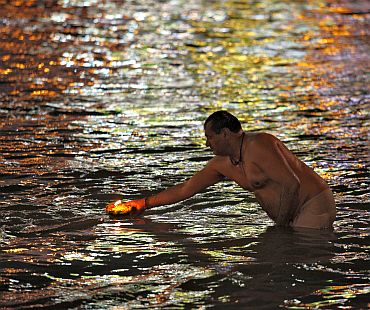
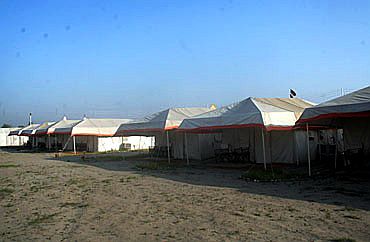
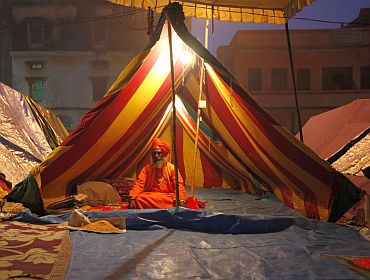

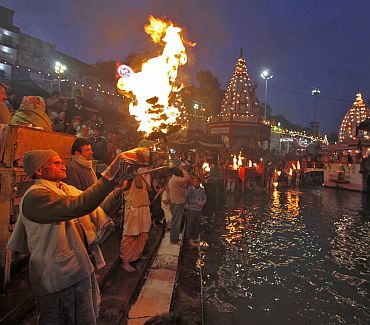
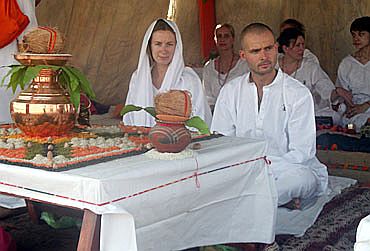
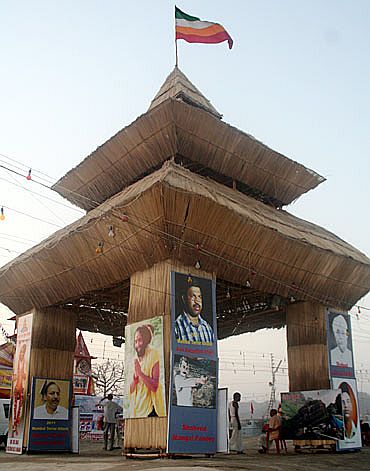

article